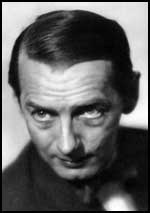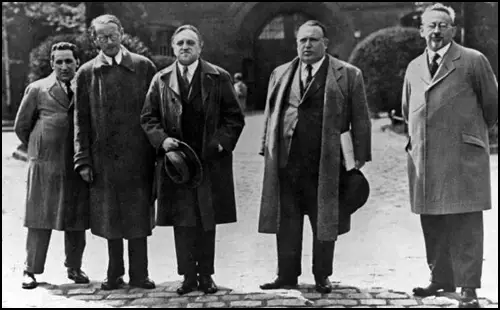Rudolf Olden

Rudolf Olden, the son of the author, Hans Olden, was born in Stettin on 14th January, 1885. His brother, Balder Olden, later wrote: "At the age of fifteen he was the complete gentleman. No speck of dust was to be found on his always perfectly pressed suit, his immaculate manners could become decidely frosty, he was slim, tall, aristocratic in every gesture."
After completing his education he joined German Army in Darmstadt. During the First World War he served on both the Western Front and the Eastern Front. He was wounded twice and by the end of the war he reached the rank of First Lieutenant.
Sickened by the slaughter of the war he became a pacifist and moved to Vienna where he edited the anti-war periodical Der Friede (Peace). In 1920 he married the psychoanalyst Marie-Christine Fournier, the daughter of the historian August Fournier. After working as a journalist for Der Neue Tag, he founded a magazine Er und Sie (He and She). Volkmar Zühlsdorff has argued: "Rudolf Olden was an impressive personality - one of the 200 figures who really counted for something in Berlin, as Kurt Tucholsky once observed. For all his sympathetic, selfless readiness to stick up for other people, he was also capable of ruthless attacks and cutting judgements when he considered them appropriate." It was claimed that whenever somebody said something foolish he had the habit of inserting his monocle and fixing his gaze on his opponent and would say two words: "You reckon?"
In 1926 Olden moved to Berlin where he was employed by Theodor Wolff, the owner of the liberal Berliner Tageblatt newspaper, as political editor. Wolff was Jewish and the newspaper became a forum for those willing to criticize the policies of the National Socialist German Workers Party (NSDAP). Olden was also a member of the managing board of the German League for Human Rights.

Olden also worked as a lawyer and successfully defended Carl von Ossietzky, the editor of Die Weltbühne, after it had published evidence that Germany was in violation of its agreements under the Treaty of Versailles. As Volkmar Zühlsdorff, the author of Hitler's Exiles (2005), has pointed out: "Olden built up a reputation throughout Germany and even abroad as defence counsel. He favoured cases which offended his pronounced sense of justice and humanity, irrespective of the status of those involved, the party they belonged to or to the political repercussions."
In January 1933 Adolf Hitler obtained power in Germany. Olden immediately helped to organize a congress Das Freie Wort, where over 1,500 artists, authors, scientists and politicians pledge their support for artistic, journalistic and academic freedoms. Warned that he was about to be arrested, Olden fled to Prague, where he continued his campaign against fascism. In 1934 he was invited by Gilbert Murray to move to London where he gave lectures on Nazi Germany and became secretary of PEN International.
In 1936 Olden published Hitler the Pawn. The book rejected the idea that Hitler won power through his own efforts. He took the view that he was presented with the opportunity by powerful figures such as Paul von Hindenburg and Franz von Papen. The book included interviews with people such as Reinhold Hanisch who knew Hitler in Vienna before the First World War. On the publication of the book Olden's German citizenship was revoked. In 1939, at the outbreak of war, Olden was interned. He was released when he was invited to lecture at the New School of Social Research in New York City.
On boarding the City of Benares, his passport was stamped with the words "No Return". It was carrying 406 passengers and crew, of whom 100 were children being evacuated to Canada and the US, most of them as part of a government scheme organized by the Children's Overseas Reception Board. On 18th September 1940, the ship was torpedoed by the German submarine U-48. As a result 258 people died, including Rudolf Olden and his wife Marie-Christine Olden. Nazi German propaganda later claimed Olden was on a mission to persuade the then-neutral United States to enter the war.
Primary Sources
(1) Rudolf Olden, Hitler the Pawn (1936)
Hitler wanted "to make himself scarce," to retreat with the fighting leagues to Rosenheim. This simply meant flight. The General had another plan. He was certain of success. No German, at any rate no German in uniform, would shoot at the "General of the World War," at the national hero. At about noon a procession of 2000 National Socialists marched, twelve abreast, through the town. At first shot Hitler had flung himself to the ground. He sprained his arm, but this did not prevent him from running. He found his car and drove into the mountains.
Student Activities
Who Set Fire to the Reichstag? (Answer Commentary)
Adolf Hitler's Early Life (Answer Commentary)
Adolf Hitler and the First World War (Answer Commentary)
Adolf Hitler and the German Workers' Party (Answer Commentary)
Sturmabteilung (SA) (Answer Commentary)
Adolf Hitler and the Beer Hall Putsch (Answer Commentary)
Adolf Hitler the Orator (Answer Commentary)
An Assessment of the Nazi-Soviet Pact (Answer Commentary)
British Newspapers and Adolf Hitler (Answer Commentary)
Lord Rothermere, Daily Mail and Adolf Hitler (Answer Commentary)
Adolf Hitler v John Heartfield (Answer Commentary)
The Hitler Youth (Answer Commentary)
German League of Girls (Answer Commentary)
Night of the Long Knives (Answer Commentary)
The Political Development of Sophie Scholl (Answer Commentary)
The White Rose Anti-Nazi Group (Answer Commentary)
Kristallnacht (Answer Commentary)
Heinrich Himmler and the SS (Answer Commentary)
Trade Unions in Nazi Germany (Answer Commentary)
Hitler's Volkswagen (The People's Car) (Answer Commentary)
Women in Nazi Germany (Answer Commentary)
The Assassination of Reinhard Heydrich (Answer Commentary)
The Last Days of Adolf Hitler (Answer Commentary)
